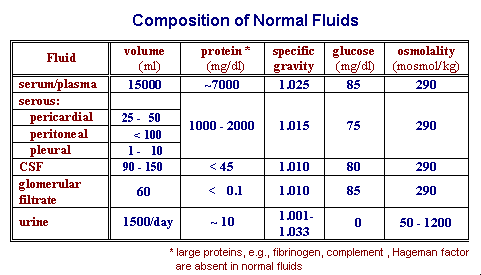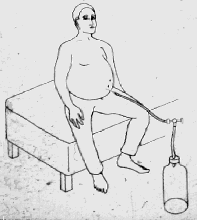
Interstitial fluid and fluid in body cavities is an ultrafiltrate of plasma. The concentration of small molecules, e.g. electrolytes and glucose, is comparable to that in plasma.

The forces responsible for fluid formation are:
1. Forces in the capillary causing fluid to flow across membranes
into the interstitium include:
capillary hydrostatic pressure (21 mm Hg)
- plasma oncotic pressure (28 mm Hg)
= - 7 mm Hg
2. Forces in the interstitium causing fluid to flow back into the capillary include:
interstitial hydrostatic pressure (1 mm Hg)
- interstitial oncotic pressure (8.5 mm Hg)
= - 7.5 mm Hg
3. There is a net positive force (~ 0.5 mm Hg) causing the continued formation of
extravascular fluid; the excess influx is drained by the lymphatic system.
Exudates are fluids of inflammatory origin and are characterized by:
 Fluid accumulation causes swelling and/or pain. Symptomatic treatment involves removal of fluid, as depicted in the figure to the right where peritoneal fluid is being aspirated. When necessary, a portion of the fluid is submitted to the laboratory for analysis. Typical laboratory analyses conducted on serous fluids are listed below along with typical results.
Fluid accumulation causes swelling and/or pain. Symptomatic treatment involves removal of fluid, as depicted in the figure to the right where peritoneal fluid is being aspirated. When necessary, a portion of the fluid is submitted to the laboratory for analysis. Typical laboratory analyses conducted on serous fluids are listed below along with typical results.
| Fluid | Volume | Protein | Neutrophils | Glucose | LDH |
|---|---|---|---|---|---|
| Transudate | Increased | Normal | Absent | Normal | Normal (Increased, if from tumor) |
| Exudate | Increased | Increased | Increased | Decreased | Increased |
Most Recent Update on 9/2/2014